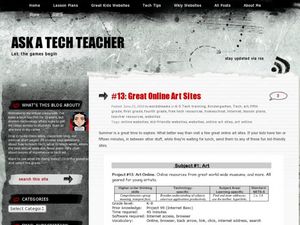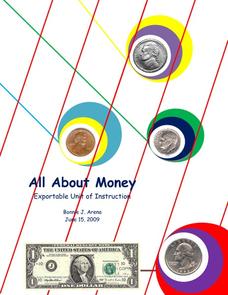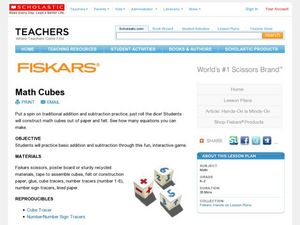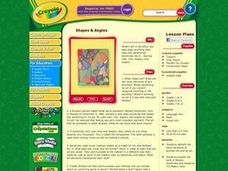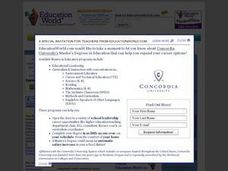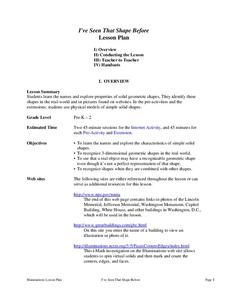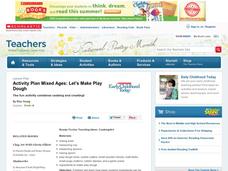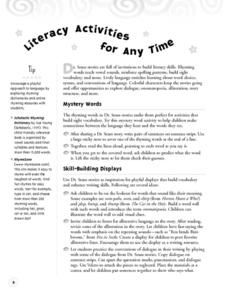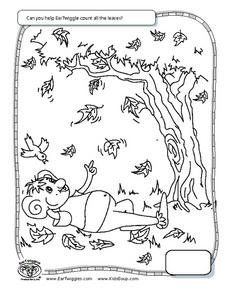August House
The Stolen Smell
Some smells are better than others! Explore your sense of smell with a series of activities based on the Peruvian folktale, The Stolen Smell. With exercises about phonics, counting, cooking, art, and drama, the lesson is a...
Baylor College
What's Is Soil Made Of?
It's time to roll up those sleeves and get a little dirty in the second lesson of this series on the science of food. Investigate where plants and animals get the minerals they need to live in this two-part exploration of soil. First,...
Curated OER
Real-Life Problems
How much does it cost to mail this letter? Scholars approach the real-life scenario of adding postage as they practice introductory addition. Each letter has a total amount it needs, and learners draw in the appropriately-priced stamps...
Curated OER
Great Online Art Sites
Students complete an online study of art websites. In this art and technology lesson, students explore the links and try the activities to learn about art online.
Curated OER
All About Money
Few topics engage young mathematicians as much as learning about money. Through a series of shared readings and hands-on activities, children explore the US currency system, learning how to count money and calculate change as they create...
Mary Pope Osborne, Classroom Adventures Program
Mummies in the Morning Egyptian pyramids, hieroglyphics
Visit the Magic Treehouse and take your class on a trip through time with a reading of the children's book Mummies in the Morning. Using the story to spark an investigation into Egyptian culture, this literature unit engages...
Curated OER
Math Cubes
Learners practice addition and subtraction while making and then playing a game. In this addition and subtraction lesson, students will make dice using a cube tracer and number and number sign tracers to make the numbers and number...
Curated OER
Language Arts, Music, Poetry: Blues Style
This instructional activity focuses on how the blues both operates as poetry and informs the poetry of many prominent African American poets. Students consider the poetic devices and recurring themes in blues lyrics and the significance...
Curated OER
Shapes & Angles
Learners identify the basic elements of abstract art and all art. They explore the work of Wassily Kandinsky and recognize his Modern style. Afterwards, they imitate the methods of Abstract artists to create their own art.
Curated OER
"Eggs-ploring" Math with Jellybeans
Learners work in pairs with a small bag of jellybeans to estimate the number of candies in their bags and then figure out how many groups of 10 jellybeans are contained in their bags. They then graph the information using a pictograph or...
Fayetteville Public Schools
I've Seen That Shape Before
The objectives in the resource allow students to explore the characteristics of simple solid shapes. Youngsters learn to recognize the face shapes, corners, and edges that make up 3-D figures by filling in a chart. Lastly,...
Asian Art Museum
Create Your Own Samurai (Breastplate) Armor
Your class is going to love this activity. They get out their rulers, cardboard, and paints as they make Samurai breastplates. The simple art lesson lends itself to many different subjects such as, math/measurement, world history, and...
K12 Reader
Conjunctions: And
Math isn't the only subject where pupils get to add! Focus on conjunctions with a grammar lesson in which class members connect nouns with the word and.
Curated OER
Let's Make Play Dough
Students create their own play dough to use for art projects. In this art lesson, students measure, pour and mix the ingredients to make their own play dough. Then, students use the clay to create their own sculptures.
Curated OER
Shapes and Patterns in Art and Oceans
First graders draw, cut out, and design their own fish shapes by cutting out shapes and putting them together. In this shapes and patterns worksheet, 1st graders also construct a stamp and print patterns with stamps to repeat a...
Curated OER
Tell Me; I’ll Listen
Encourage respect, responsibility, and caring within your classroom with a collection of lessons that spark dialogue and self reflection. To address character traits, lessons touch on topics such as staying safe in the...
US Apple Association
Apples: A Class Act! (Grades Pre-K–3)
Discover the nutritional wonders of apples and get to know Johnny Appleseed with a plethora of learning experiences that cover subjects math, history, English language arts, health, and arts and crafts. Activities include an apple...
Curated OER
Barter vs. Money
First graders listen to the book, Sheep in a Shop, that leads them to think about making financial decisions, trading, and the barter system. After the book is read aloud, a discussion ensues about some of the things that the sheep...
Curated OER
Wants and Needs
Here is an outstanding lesson on wants versus needs designed for 1st graders. Pupils listen to the book, Something Good which presents themes on wants, needs, choice, resources, and counting money. Pupils complete worksheets embedded in...
Curated OER
Mitten Mania
Youngsters listen to the classic Jan Brett book, The Mitten, then gain strength in utilizing listening skills, developing vocabulary, practicing sequencing events, and expressing themselves through movement and art projects. This rich...
Scholastic
Literacy Activities for Any Time
As the title suggests, this packet is loaded with activities that can be used at any time. The common element in all the exercises is that they are connected to books by Dr. Seuss.
Curated OER
Community Helpers
The book, Doctor Ted is used to kick off this lesson on Community Helpers. Young learners make connections to their own life by dictating a story of their own, and inventing other jobs that Ted can do.
WakeGOV
Plastic Sight Words
Plastic math? Have young learners count and name the number of plastic items in their centers. Kindergartners match sight word cards to the number of plastics in a given group, while learning that plastics come in all different shapes,...
Curated OER
EarTwiggle
In this counting leaves worksheet, young scholars assist EarTwiggle in counting all the leaves found within a piece of art and then place their answer in the box provided at the lower right hand corner.



